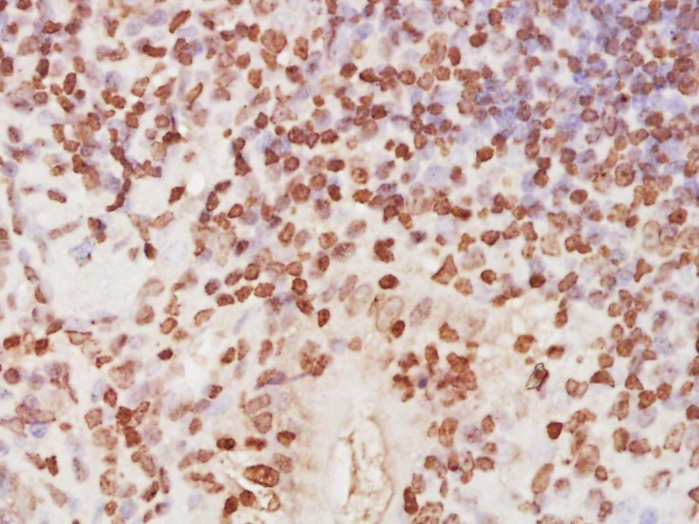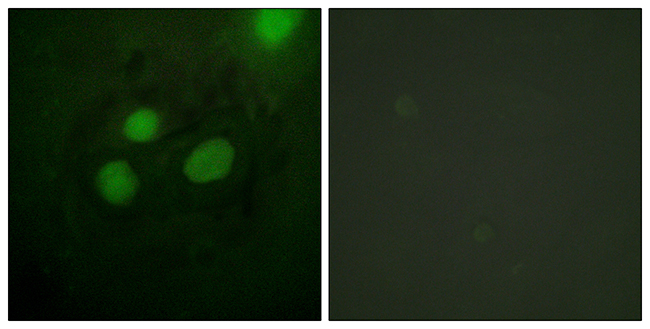RPA32 antibody [12F3.3]
GTX70243
ApplicationsImmunoFluorescence, ImmunoPrecipitation, Western Blot, ImmunoCytoChemistry
Product group Antibodies
TargetRPA2
Overview
- SupplierGeneTex
- Product NameRPA32 antibody [12F3.3]
- Delivery Days Customer9
- Application Supplier NoteWB: 1:500-1:3000. ICC/IF: 1:100-1:1000. *Optimal dilutions/concentrations should be determined by the researcher.Not tested in other applications.
- ApplicationsImmunoFluorescence, ImmunoPrecipitation, Western Blot, ImmunoCytoChemistry
- CertificationResearch Use Only
- ClonalityMonoclonal
- Clone ID12F3.3
- Concentration1 mg/ml
- ConjugateUnconjugated
- Gene ID6118
- Target nameRPA2
- Target descriptionreplication protein A2
- Target synonymsREPA2, RP-A p32, RP-A p34, RPA32, replication protein A 32 kDa subunit, RF-A protein 2, replication factor A protein 2, replication protein A 34 kDa subunit
- HostMouse
- IsotypeIgG2a
- Protein IDP15927
- Protein NameReplication protein A 32 kDa subunit
- Scientific DescriptionThis gene encodes a subunit of the heterotrimeric Replication Protein A (RPA) complex, which binds to single-stranded DNA (ssDNA), forming a nucleoprotein complex that plays an important role in DNA metabolism, being involved in DNA replication, repair, recombination, telomere maintenance, and co-ordinating the cellular response to DNA damage through activation of the ataxia telangiectasia and Rad3-related protein (ATR) kinase. The RPA complex protects single-stranded DNA from nucleases, prevents formation of secondary structures that would interfere with repair, and co-ordinates the recruitment and departure of different genome maintenance factors. The heterotrimeric complex has two different modes of ssDNA binding, a low-affinity and high-affinity mode, determined by which oligonucleotide/oligosaccharide-binding (OB) domains of the complex are utilized, and differing in the length of DNA bound. This subunit contains a single OB domain that participates in high-affinity DNA binding and also contains a winged helix domain at its carboxy terminus, which interacts with many genome maintenance protein. Post-translational modifications of the RPA complex also plays a role in co-ordinating different damage response pathways. [provided by RefSeq, Sep 2017]
- Storage Instruction-20°C or -80°C,2°C to 8°C
- UNSPSC12352203
References
- Beck C, Boehler C, Guirouilh Barbat J, et al. PARP3 affects the relative contribution of homologous recombination and nonhomologous end-joining pathways. Nucleic Acids Res. 2014,42(9):5616-32. doi: 10.1093/nar/gku174Read this paper
- Yoshihara T, Ishida M, Kinomura A, et al. XRCC3 deficiency results in a defect in recombination and increased endoreduplication in human cells. EMBO J. 2004,23(3):670-80.Read this paper




![FACS analysis of HeLa cells using GTX83688 RPA32 antibody [8B3]. Red : Primary antibody Blue : Negative control antibody](https://www.genetex.com/upload/website/prouct_img/normal/GTX83688/GTX83688_118_FACS_w_23061420_151.webp)
![FACS analysis of HeLa cells using GTX83691 RPA32 antibody [1H10]. Red : Primary antibody Blue : Negative control antibody](https://www.genetex.com/upload/website/prouct_img/normal/GTX83691/GTX83691_120_FACS_w_23061420_588.webp)
![FACS analysis of HeLa cells using GTX83695 RPA32 antibody [7C12]. Red : Primary antibody Blue : Negative control antibody](https://www.genetex.com/upload/website/prouct_img/normal/GTX83695/GTX83695_123_FACS_w_23061420_911.webp)
![IHC-P analysis of human breast carcinoma tissue using GTX15783 RPA32 antibody [MA34]. Left : Primary antibody Right : Negative control without primary antibody Antigen retrieval : heat induced antigen retrieval was performed using 10mM sodium citrate (pH6.0) buffer, microwaved for 8-15 minutes Dilution : 1:20](https://www.genetex.com/upload/website/prouct_img/normal/GTX15783/GTX15783_1041_IHC-P_w_23060620_950.webp)